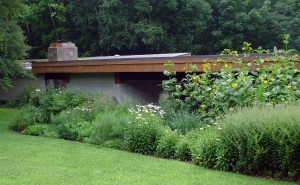When I teach lawn management, the first point I make to my students is the lawn is so important its location must be selected first when you are designing a new landscape. Decide where you want to play, gather and circulate—that should be lawn. The rest of your landscape should be something else. What else, you say? You really have three choices: traditional landscape beds, forest or meadow. Traditional landscape beds provide lots of interest and beauty in a garden but they can be costly to install and take a lot of time to maintain. Most landscapes will have some traditional landscape beds. Using mulch to reduce weeds and locating plants to be the tree canopy, shrub layer and groundcover make landscape beds more manageable. Using native plants attracts native wildlife. Starting small and allowing plants to grow together will reduce the initial cost and allow plants to establish more easily.
The second option is a forest or woodland. Most people think they don’t have a large enough property for a forest, but you can have a small tree grove (i.e. forest) on very little land. And it doesn’t have to cost anything. At the University of Delaware Botanic Garden we let a small area of what used to be a golf course become a forest over the course of about 15 years. The trees (red maple, sweet gum, black cherry, birch, tulip poplar, oak) were all planted by the birds, squirrels and wind. The only maintenance involved was removing exotic invasive species that might have taken over the forest if we had allowed them. So, if you have 10 years, stop mowing and eventually you will have a forest. If you want to jump start the process, plant small trees, woodland shrubs (i.e. spicebush, viburnum, witchhazel) and forest ground cover (ferns, wood asters, celandine poppy).
Option three is the least expensive but also least understood landscape—a meadow. Fortunately, Longwood Gardens is attempting to change our perception of a meadow. Visit Longwood Gardens’ meadow–just opened to the public this June. It is 86 acres and contains 3 miles of walking trails. Obviously larger than a typical residential meadow, it shows the visitor various components of meadow that could be incorporated into a home landscape. The back bone of the meadow is warm season grasses. Indiangrass, switchgrass, prairie dropseed and little bluestem are a few of the grasses native to our region. Throughout the meadow, you will see blooming perennials like butterfly weed and black-eyed Susan. At key nodes in the meadow, such as path intersections, bridges, benches and other structures, you will find more flowering perennials planted in masses. The vistas are wonderful but the details are also charming. One of the most important parts of the meadow is the path systems. Paths provide access to a meadow and also show the meadow is being managed.
How can you incorporate a meadow into your home landscape? Many people have large front lawns that are used for nothing other than taking a few hours weekend time to mow. Keep a small area of maintained lawn around the house and let the rest of the lawn become a meadow. Be sure to mow the edges routinely and if the yard is large enough, mow a curving path through the meadow. It could be your back or side yard isn’t serving an important function and could become a meadow, reducing the time spent mowing, helping water infiltrate into your soil, providing a home for wildlife (birds and butterflies) and providing a different and desirable aesthetic to your home. The least expensive way to start a meadow is to simply stop mowing. The plants that come in will depend on your soil, moisture available and surrounding area. If you want to jump start the process you can seed a meadow (for more information on seeding a meadow refer to this brochure: http://extension.udel.edu/lawngarden/files/2012/06/live_eco_final.pdf). Another great meadow example can be found at the Mt. Cuba Center. Start to explore the possibility of having your own meadow and spend your weekends admiring the birds instead of cutting the grass.



